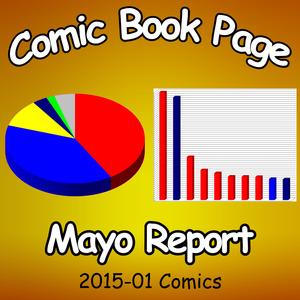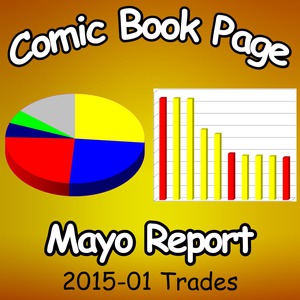Mayo Report for 2015-01

|

|
Top Comics List Top Comics Breakdown Top Trades List Top Trades Breakdown
Unlike December, there was a very clear "winner" in January 2015. "Star Wars" #1 sold an estimated 985,976 units through Diamond setting a new sales record for the final order era which started when Diamond began reporting invoiced sales to retailers in March 2003. Marvel accounted for 51.06% of the top units for the top 300 comics while DC accounted for 28.51%. Even without "Star Wars" #1, Marvel would have had 42.77% of the unit sales compared to 33.34% for DC. "Star Wars" #1 certainly helped Marvel but overall Marvel has stronger selling titles than DC does right now. This is the strongest lead Marvel has had over DC since June 2009.
"Star Wars" #1 was reported to have sold over 1,000,000 units and the estimate I give does not contradict that claim by Marvel. As a reminder, the numbers I talk about in these articles is what was invoiced by Diamond to comic book retailers in North America. While this isn't a complete picture of the overall sales for comics, it is clearly the driving sales channel in the industry. The difference between what Marvel reported as sold and what Diamond reported as sold comes from both other sales channels than Diamond and any copies Diamond has for reorders and hasn't yet invoiced to retailers.
Not only did "Star Wars" #1 outsell the 556,457 estimate units for "Amazing Spider-Man (2014)" #1 and the 524,943 estimate units for "Amazing Spider-Man (1963)" #583 but it also outsold the 705,277 estimate units for the 9 cent "Fantastic Four (1998)" #60 and the 10 cent "Batman: The Ten Cent Adventure" #1. "Star Wars" #1 has a $4.99 cover price. At full cover price, the sales equate to $4,920,020.24. All of the publisher other than Marvel and DC have been averaging a total of less than that during the final order era but have been usually selling more than that over the past two years.
It is also worth noting that the retail value of "Star Wars" #1 is more than DC had in the top 300 is a couple of months including January and May of 2011. Obviously the "Star Wars" #2 which shipped on February 4th, 2015 will have what appears to be an unprecedented second issue drop since it is likely to sell closer to a sustainable sales level. A drop around 90% putting it in the 90,000 to 100,000 would not surprise me. I would live to be wrong about that and to see "Star Wars" consistently selling over 100,000 units.
Only two other titles sold over 75,000 units. "Batman" #38 sold around 110,232 units. "Amazing Spider-Man" #12 sold approximately 105,458 units and "Amazing Spider-Man" #13 sold an estimated 103,093 units. "Batman" has routinely sold well since the New 52 relaunch in 2011. The sales for "Amazing Spider-Man" are more dependent on cover gimmicks and event stories like the current Spider-Verse arc.
Only another dozen items sold over 50,000 units. Three of those were first issues from Marvel so we can expect drops on those, possibly enough to put those titles under 50,000 with the next issue. The weekly "Wolverines" was one of those three titles. "Wolverines" #2 sold 43,573 units, "Wolverines" #3 sold 42,051 units and "Wolverines" #4 sold 39,790 units. While "Wolverines" started the month over 50,000 units by a wide margin, it ended the month well below 50,000 units.
To recap, 14 titles sold over 50,000 units in January 2015. Five of them ("All New X-Men," "Guardians of Galaxy," "Detective Comics," "Batman and Robin" and "All New Captain America") did so by less than 1,825 units. Of the remaining ten, one sold at clearly unsustainable levels and two others ("Uncanny Avengers" and "Ant-Man") were first issues and if they drop like a typical Marvel first issue these days, will drop below 50,000 units on the second issue. One of the remaining six titles has a quasi-event going on ("Amazing Spider-Man" with the Spider-Verse storyline) and another title ("Thor") is still in the opening storyline with a new lead character. Both of those two titles are benefiting from a sales surge caused by telling a story more people want to read. On the off chance I haven't been clear on this in the past, I approve of and strongly encourage this method of increasing sales. Comics should sell based on the strength of the stories they tell. The question is if those two titles can keep the sales up with the next storyline. "Amazing Spider-Man" stands a good chance of doing so given the past sales on the current volume.
Both "Batman" and "Amazing Spider-Man" are strong sellers. "Justice League," "The Walking Dead" and "Harley Quinn" are all selling in the 64,000 to 69,000 range and were the next best-selling titles in January. It begs the question of what the "strong sales" should be defined as. For me, that terms means one thing for Marvel and DC and another thing for the other publishers. The unfortunate reality is all other things being equal, comics from Marvel and DC sell-better than comics from other publishers. I'd be hard pressed to name a comic book store which doesn't carry Marvel and DC titles. I've heard all too many stories of shops which carry little else. The other publishers are forced into a lower sales bracket as a result. It isn't fair but it is happening. The question is what the term "strong sales" should mean in terms of Marvel and DC titles. Should it be relative to current sales levels or should it be a more stable and objective level of sales. "Avengers" #40 sold an estimated 47,483 units and placed in the top 20 comics. But it is a "strong seller" or not? I tend to use the phrase in relative to the current sales levels since any numerical level might seem reasonable at one point and practically unobtainable at another point.
The average comic simply doesn't sell all that well. The top three items in January sold more than the bottom half of the top 300 comics list. The top 50 slots sold more than the remaining 250 slots on the list. A handful of comics sell great, a few dozen sell well and most sell good to no-so-good depending on how you define "good" sales. The key here is selling "good enough" which can be defined as making enough of a profit to keep the title going. The profitability point for each title depends on the cost of creating the content, any corporate overhead and the cost of printing and shipping the comics.
I'm not going to tell you to go buy more comics. Obviously if readers buy more, sales will pick up by definition. But the responsibility for sales isn't on the readers, it is on the creators, publishers and retailers. Readers not buying enough comics isn't the problem. It is a symptom of the real problem.
There are a number of things which could be the real problem. Maybe publishers aren't publishing the comics readers want. Maybe retailers aren't able to stock the right comics for their customers. Maybe the right comics are available but the right readers don't know about them. Maybe comics cost too much and readers can't afford all of the comics they want. Maybe readers don't want shared universe or to deal with continuity. Conversely, maybe readers do like shared universes and continuity and are disappointed by the way publishers are handling them.
Maybe there aren't enough jumping-on points. Or, maybe the problem is deeper than that. Maybe readers don't need issues marked as jumping-on points but need issues geared for readers to jump into the story with a solid enough understanding and enjoyment of the issue to stay enough in the story to get the next issue. There is a world of difference between an issue with a #1 on the cover and a comic written to be the first issue of a title for a reader. A true first issue for a reader introduces the characters, concepts, tone and style of the series and gives the reader a sense of the nature of the series with enough information on all of that to make an informed decision if the title is right for them or not. Those are good jumping-on points. A good jumping-in issue goes a step further and immerses the reader deep enough into the story they want to come back for more. It is the difference between being introduced to someone and having a meaningful conversation with them. If you are just introduced to someone you may or may not remember their name later. Even if you can remember their name, do you even have a reason to do so. But if you have a meaningful conversation with someone, you are much more likely to remember the person and the conversation. Even if you don't remember the person's name, you have a reason to try to remember it. Some comics have first issues which are those jumping-in issues. Those are the ones you hear about.
If you think I'm being overly-pessimistic about the state of comic book sales then ask yourself why Marvel is continuing to average new ongoing a week as they have for over a year and why DC is launching another two dozen new titles after "Convergence." The simple answer is what they are currently publishing isn't selling. The real question is why the titles aren't selling. Until that question is answered and a viable solution is found, the majority of comics will continue to lose sales issues after issue requiring low selling titles to get replaced by better selling ones which launch high, lose sales and get replaced themselves. Until that situation changes, sales might be up but they aren't going up and there is a big difference between the two.



